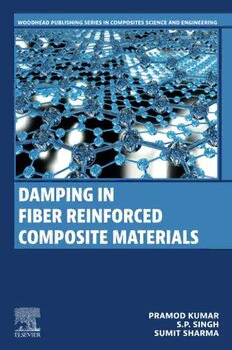
Damping in Fiber Reinforced Composite Materials PDF
Preview Damping in Fiber Reinforced Composite Materials
WoodheadPublishingSeriesin CompositesScienceandEngineering DAMPING IN FIBER REINFORCED COMPOSITE MATERIALS PRAMODKUMAR Assoc.Professor,Dr.BRAmbedkarNationalInstituteofTechnology(NIT) Jalandhar,Punjab,India S.P.SINGH Professor,DepartmentofMechanicalEngineering,IndianInstituteof TechnologyDelhi,HauzKhas,NewDelhi,India SUMITSHARMA AssistantProfessor,Dr.BRAmbedkarNationalInstituteofTechnology(NIT) Jalandhar,Punjab,India Editor-in-Chief ProfessorCostasSoutis HeadofAerospaceEngineering,UniversityofManchester,UK SeriesEditors ProfessorAdrianMouritz ExecutiveDean,RMIT,Australia ProfessorSureshAdvani Assoc.Director,CentreforCompositeMaterials,Univ.Delaware,USA ProfessorBodoFiedler DirectorInst.PlasticsandComposites,TUHamburg,Germany ProfessorLeifAsp DivisionofMaterialsandComputationalMechanics,Chalmers,Sweden ProfessorYurisA.Dzenis,R.VernonMcBroom ProfessorofEngineering,DepartmentofMechanicalandMaterialsEngineering UniversityofNebraska-Lincoln,USA ProfessorChunH.Wang HeadofSchoolofMechanicalEngineering,UNSW,Australia DAMPING IN FIBER REINFORCED COMPOSITE MATERIALS WoodheadPublishingisanimprintofElsevier 50HampshireStreet,5thFloor,Cambridge,MA02139,UnitedStates TheBoulevard,LangfordLane,Kidlington,OX51GB,UnitedKingdom Copyright©2023ElsevierLtd.Allrightsreserved. Nopartofthispublicationmaybereproducedortransmittedinanyformorbyany means,electronicormechanical,includingphotocopying,recording,oranyinformation storageandretrievalsystem,withoutpermissioninwritingfromthepublisher.Detailson howtoseekpermission,furtherinformationaboutthePublisher’spermissionspolicies andourarrangementswithorganizationssuchastheCopyrightClearanceCenterandthe CopyrightLicensingAgency,canbefoundatourwebsite:www.elsevier.com/permissions. Thisbookandtheindividualcontributionscontainedinitareprotectedundercopyright bythePublisher(otherthanasmaybenotedherein). Notices Knowledgeandbestpracticeinthisfieldareconstantlychanging.Asnewresearchand experiencebroadenourunderstanding,changesinresearchmethods,professional practices,ormedicaltreatmentmaybecomenecessary. Practitionersandresearchersmustalwaysrelyontheirownexperienceandknowledgein evaluatingandusinganyinformation,methods,compounds,orexperimentsdescribed herein.Inusingsuchinformationormethodstheyshouldbemindfuloftheirownsafety andthesafetyofothers,includingpartiesforwhomtheyhaveaprofessionalresponsibility. Tothefullestextentofthelaw,neitherthePublishernortheauthors,contributors,or editors,assumeanyliabilityforanyinjuryand/ordamagetopersonsorpropertyasa matterofproductsliability,negligenceorotherwise,orfromanyuseoroperationofany methods,products,instructions,orideascontainedinthematerialherein. ISBN:978-0-323-91186-3 ForInformationonallWoodheadPublishingpublicationsvisitour websiteathttps://www.elsevier.com/books-and-journals Publisher:MatthewDeans AcquisitionsEditor:GwenJones EditorialProjectManager:TomMearns ProductionProjectManager:FizzaFathima CoverDesigner:MilesHitchen TypesetbyAptara,NewDelhi,India Contents Preface vii 1. Introduction 1 1.1 Objectiveofthebook 3 1.2 Outlineofbook 4 References 5 2. Methodsofmodelingdamping 7 2.1 Introduction 7 2.2 Macromechanicalapproach 12 2.3 Micromechanicalapproach 18 2.4 Nonlineardamping 30 2.5 Conclusion 36 References 37 3. Measurementofdamping 45 3.1 Measurementofdampingfromdecayplot 45 3.2 Ageneralizedmethodoffindingdamping 47 3.3 Multimodeevaluationofdamping 49 3.4 Dampingratiofordifferentmodesofdeformation 51 3.5 Resonalysermethodofevaluationofdampingcoefficientmatrix 53 3.6 Frequencydependenceofdamping 54 3.7 Concludingremarks 54 References 55 4. Micromechanicalstudyoftwo-phasecomposite 57 4.1 Micromechanicalmodels 57 4.2 Fiberpackinggeometry 65 4.3 Finiteelementapproach 69 4.4 Mathematicalmodelforfrequencydependence 74 4.5 Resultsanddiscussions 76 4.6 Conclusion 95 References 96 5. Modelingofthreephasecomposite 99 5.1 Mathematicalmodelingofthreephasecomposite 99 v vi Contents 5.2 Finiteelementsmodel 104 5.3 Frequencydependenceofthreephasecomposite 106 5.4 Resultsanddiscussion 106 5.5 Conclusion 124 References 125 6. Modelingofnonlineardamping 127 6.1 Introduction 127 6.2 Mathematicalmodel 128 6.3 Resultsanddiscussions 132 6.4 Conclusion 138 References 139 7. Applicationsofdampingandprinciplesofvibrationcontrol 141 7.1 Applicationsofdamping 141 7.2 Principlesofvibrationcontrol 151 References 159 Index 161 Preface The primary audience targeted for this book include researchers working in the area of damping in composite materials.Currently,no book on the market explains the basics of damping in composites.The proposed book will cover the basics of damping in composites,and modeling (in Matlab), as well as in FEM.The book will also include the basics of the dynamic behavior of composites and will explain the use of a dynamic mechanical analyzerinpredictingdampingincomposites.Peopleworkinginthefieldof mechanical engineering,industrial engineering,biotechnology,and physics will find this book useful in predicting the damping behavior of fibrous composites.Furthermore,thebookcanbeusedasatextbookon“Damping in Composites”for postgraduate and doctorate-level students.Those who wanttolearnmoreaboutthebasicsofdampingincompositeswillfindthis book extremely helpful,as there is no other book published on this topic. Damping is an important parameter for measuring and predicting the dynamicperformance ofcompositematerials.Inthisexemplarynewbook, the authors discuss damping behavior in fiber-reinforced composites.Di- vided into 7 main chapters, the book starts with an introduction to the basic concepts of damping in composite materials. Methods of modeling damping are then discussed in chapter 2. These include both macro and micro-mechanical approaches.Chapter 3 deals with experimental methods for measuring damping. The decay plot and circle methods have been discussedindetail.Inchapter4,aparametricstudyofatwo-phasecomposite materialispresentedusingdifferentmicromechanicalmodels,suchasunified micromechanics, and Hashin Eshelby’s to predict elastic moduli and loss factors. A bridging model that incorporates the effect of fiber packaging factors is then compared to FEM results.Chapter 5 investigates the effect of the interphase on the mechanical properties of the composite.A mathe- matical model is developed for the prediction of elastic moduli of a three- phase fiber-reinforced composite. Chapter 6 presents a nonlinear model for the prediction of damping in viscoelastic materials. The final chapter looks at some of the main engineering applications of damping in real life and principles of vibration control. The readers will be able to infer the vii viii Preface importance of damping and principles of vibration control in FRPs after reading this chapter. The book will be an essential reference resource for academic and industrialresearchersworkinginthefieldofcompositematerials,especially damping behavior. Pramod Kumar Assoc.Professor,Dr.B.R.Ambedkar National Institute of Technology Jalandhar,Punjab,India S.P.Singh Professor,Department of Mechanical Engineering, Indian Institute of Technology Delhi, Hauz Khas,New Delhi India Sumit Sharma Assistant Professor,Dr.B.R.Ambedkar National Institute of Technology Jalandhar,Punjab,India June 2022 CHAPTER 1 Introduction Astructuralcompositeisamaterialsystemconsistingoftwoormorephases on a macroscopic scale whose mechanical performance and properties are designedtobesuperiortothoseoftheconstituentmaterialsactingindepen- dently.One of the phases is stiffer and stronger and is called reinforcement and the less stiff and weaker phase is known as matrix.Because of chemical interaction or other processing effects, an additional distinct phase called interphase exists between the reinforcement and matrix. The properties of composite materials depend on the properties of its constituent, their geometry,andthedistributionofthephases.Thepropertiesofthecomposite materials combine the best features of each constituent to maximize a given set of properties, that is, stiffness, strength-to-weight ratio, tensile strength, and minimize others, such as weight and cost. Composites have auniqueadvantageovermonolithicmaterials,suchashighspecificstrength, high specific stiffness, tailored damping, and adaptability to the intended function of the structure. These materials are being used extensively for varioushightechnologyapplications,suchasspacecraftandaircraftstructural components,gasturbines,marine,andautomobileapplications.Theendless research for reliable and low-cost structural and material system resulted in inexpensivefabricationmethods,whichhavemadecompositesaffordableto several appliances. POLYMER-MATRIXcomposites(PMCs)andmetal-matrixcompos- ites (MMCs) are two of the broad categories of composite materials in terms of matrix classification.PMCs are typically used in low-temperature structural applications,such as in civil structures,biomedical implants,au- tomobiles,and airframe structures.The fibers typically provide the stiffness and strength to the composite and can be made from a wide variety of materials,includingglass,graphite,Kevlar,andboron,asexamples.Thefibers canbearrangedinalmostanyfashion,rangingfromtotallyrandomtohighly structuredandorganized.InMMCs,thematrixphaseconsistsofcontinuous metallic material,such as aluminum,titanium,magnesium,copper,etc.The reinforcing constituent is normally ceramic (e.g., silicon carbide, silicon nitride,alumina).MMCsareusedintheaerospaceindustryforairframeand spacecraftstructures,aswellasintheautomotive,electronic,andevenleisure DampinginFiberReinforcedCompositeMaterials. Copyright©2023ElsevierLtd. DOI:https://doi.org/10.1016/B978-0-323-91186-3.00004-6 Allrightsreserved. 1
